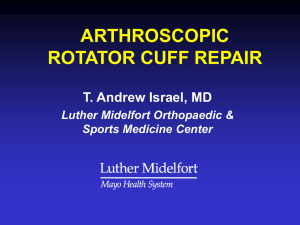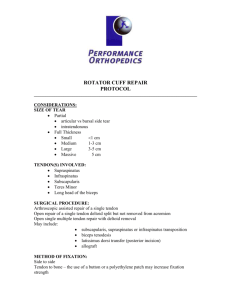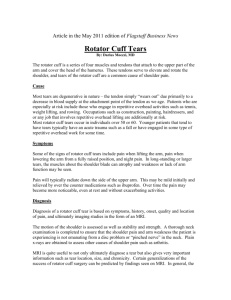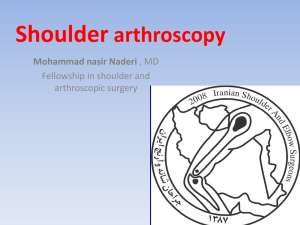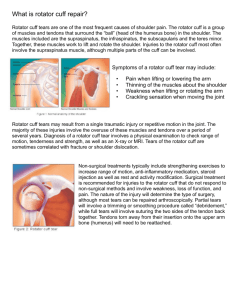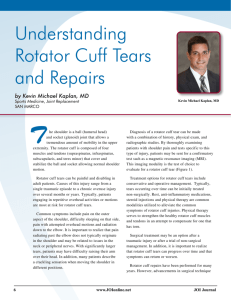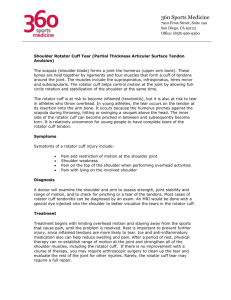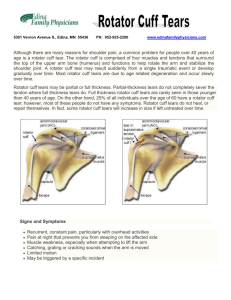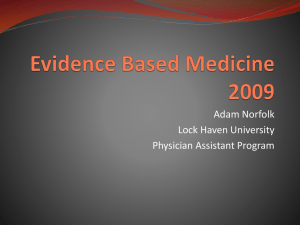Vailas: Rotator Cuff Repair Power Point
advertisement
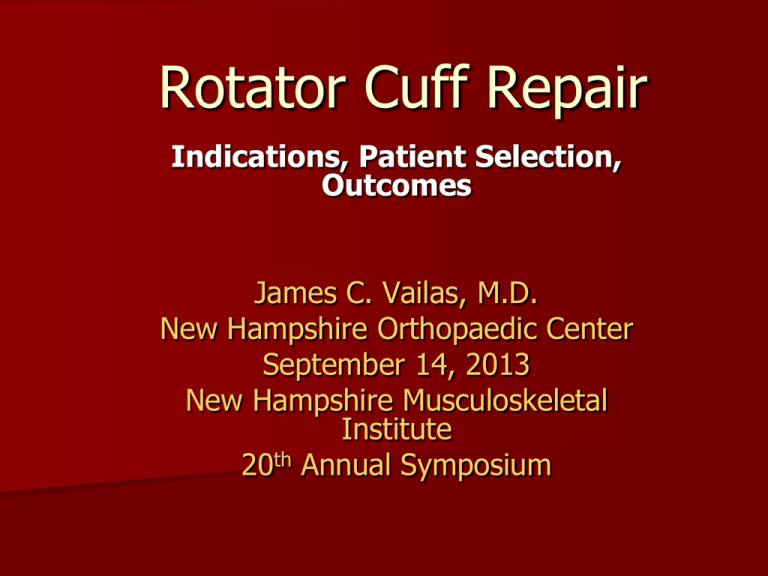
Rotator Cuff Repair Indications, Patient Selection, Outcomes James C. Vailas, M.D. New Hampshire Orthopaedic Center September 14, 2013 New Hampshire Musculoskeletal Institute 20th Annual Symposium Evolution of Arthroscopic Repair Lanny Johnson, M.D., 1985, staple repair Eugene Wolf, M.D., 1990, suture repair with metal anchor (Mitek GII) Evolution of Arthroscopic Repair Similar to capsulorraphy – – – – – – – – Diagnostic convert to open Treating other pathologies Learning curve Continuous improvement techniques Continuous improvement in outcomes Decreased morbidity Outpatient Rehabilitation TRENDS OF REPAIRS 141% increase 1996-2006 – Arthroscopic increased 600% open 34% – Repairs done ASCs quadrupled Colvin et al, JBJS Am, Feb. 2012 Acromioplasties decreased 10% 2004-09 – Mauro et al, JBJS Am, Aug. 2012 Rotator Cuff Repair Anatomy – Gross and Arthroscopic Pathological anatomy Surgical Indications for Repair – Patient Selection Arthroscopy Set-up Surgical Procedures / Techniques Rehabilitation Clinical Outcomes Shoulder Girdle Clavicle 1st Rib Scapula Coracoid Bicipital groove Humerus Glenohumeral Joint Acromion Coracoid Process Humeral Head Glenoid Rotator Cuff Subscapularis Anterior View Rotator Cuff Acromion Supraspinatus Infraspinatus Teres Minor Outlet View CA Ligament Coracoid Acromion Biceps Tendon Rotator Cuff Supraspinatus Coracohumeral ligament Infraspinatus Subscapularis Teres Minor Lateral View Acromion Classification Bigliani I. Flat II. Curved III. Hooked MRI ANATOMY Supraspinatus capsule Rotator Cuff Tear Supraspinatus tear Bursal tear Intraartiuclar tear Intra-articular Biceps Rotator Cuff Tear Cuff Humeral Head Associated Diagnoses & Pathology – Impingement: Bursitis; – Biceps: Tendonitis, tears, SLAP – Acromioclavicular arthritis – Instability Surgical Indications Patient Selection Symptoms - History – True shoulder pain Lateral acromial and arm, not forearm – Duration >3mos. – night pain – functional disability with ADLs – Failed rehab Surgical Indications Patient Selection Physical Exam – Painful active ROM impingement – Cuff weakness Comparative Drop-armsupraspinatus Horn Blowersinfraspinatus Belly press testsubscapularis Lift-off test Surgical Indications Patient Selection MRI – Complete tears MRI arthrogram – Partial tears: >50% Surgical Relative Contra-indications Age: >65y.o. Fatty atrophy of muscle (Goutallier 4) Arthritis Large tears, high demands Massive tears (2 tendons retracted) Adhesive capsulitis Arthroscopy Setup Lateral Decubitus Arthroscopy Setup Sitting- Captain’s Chair Surgical Procedures – – – – – Decompression SLAP Repair Rotator Cuff Repair Distal clavulectomy Biceps tenodesis/ tenotomy Decompression Acromion Rotator Cuff Repair Preop Preparation -Inflammation & pain Pre-emptive meds – COX2 NSAID 48hrs – Acetaminophen: 1grm. – Motion: balance flexibility – Patient education & expectations Immobilization ADL’s Return to work/sport Long-term symptoms & function Surgical Technique Cuff Preparation Portal Position Bursectomyvisualization Tear Patterncrescent, laminated, L, partial Tendon Debridement Mobilization / Releases Surgical Technique Trans-tendon Single row anchors Double row anchors – Crossbridging Augments Massive tears Platelet Rich Plasma Rehabilitation Debate – Early Passive motion necessary? Kim et al, Level I PRC study, 105 pts no motion vs passive first four wks -ASES, SST, cuff integrity- no difference ……is likely safe, it is also not inherently necessary AJSM 2012 April Rehabilitation Debate Early aggressive vs. limited passive motion – Lee et al, Level II RC, 64 pts motion increased 3mos.; same 1 yr trend for increase tears Arthroscopy 2012 Jan Rehabilitation Immobilizer Passive motion – 7-10 days Active assisted 6-8 wks Resistance exercise 3 months Strenuous exercise 56 months Full “normal” 915mos. Open repairs Outcomes Coefield JBJS 1985 – 87% pain relief – 77% pt. Satisfaction Baker & Liu,AJSM 1995 – 80% good –excellent – 88% pt. satisfaction Overall results: 71-92% – Improved pain, function, strength Smaller tears had better healing and functional outcome Gazielly et al CORR 1994 Open repairs Outcomes Residual defects: 34-90% Eugene Wolf, Arthroscopy, 2004 20% with SS tendon repair 57% with 2 tendon repairs 66% with 3 tendon repairs Harryman et al JBJS 1991 41% with 2 tendon repairs Gazielly et al CORR 1994 Comparison Mini-open vs. All-Arthroscopic Weber et al, 2004 AOSSM – 154pts. mini-open & 126 All-arthro • Large tears excluded – min. f/u 6yrs. – ASES, UCLA, SST scores equivalent – Retear rates similar All-arthro significant reduction peri- operative morbidity All Arthroscpic Repair Massive Tears Galatz & Yamagucchi, JBJS ’04 – 18pts. 2 or more tendon tears – Ave.age 61 – min. f/u 2yrs; ave 36mos. – ASES scores: Pre-op 48.3 – Post-op 79.9 – U/S evaluation: 17/18 retears – All pts. satisfied Possible causes for retears: 1 anchor/1 suture technique; immediate active pulley exercise All Arthroscopic Repairs >90% Satisfaction long term 10yrs – 6-8% continued pain and/or weakness Intrinsic factors: A-C jt, G-H jt OA; labrum, biceps, deltoid, impingement, adhesive capsulitis, instability Extrinsic factors: cervical spine, suprascapular nerve Millet PJ et al, JSES 2011 All Arthroscopic Repairs Literature review 6-24mos f/u – 60-90% healed by imaging – Significant difference in strength/function healed vs. un-healed Not all repairs that fail to heal are symptomatic Slabaugh et al, Arthroscopy 2010 Outcomes Summary All repair techniques Patient satisfaction high Pain relief high Despite structural failures, outcomes better Larger the tear the poorer outcome Better cuff integrity, better functional outcome Current Challenges – Younger, active pt. with large tear – Better tendon healing – Modifying rehabilitation appropriate for biology of healing – Decrease cost of instruments and anchors – Establish easier techniques All Arthroscopic Advantage Visualizing and magnifying cuff tear Multiple angles to tear Treating associated pathology Short term recovery Pain and ROM Large tears – Avoiding deltoid morbidity – Better mobilization Historical progression of orthopaedic surgery All-arthroscopic Rotator Cuff Repairs Surgeon Specific Technique Poorly done arthroscopic repair is worse than a well-done mini-open repair. Thank You!
